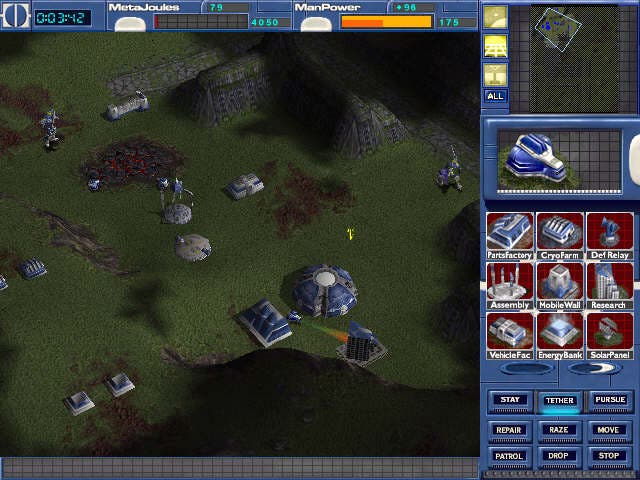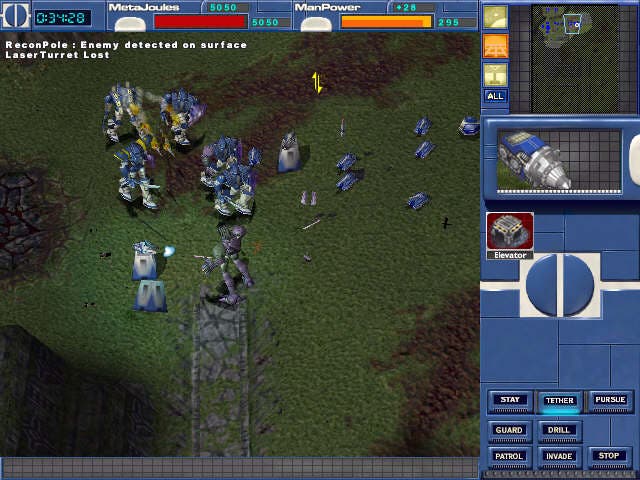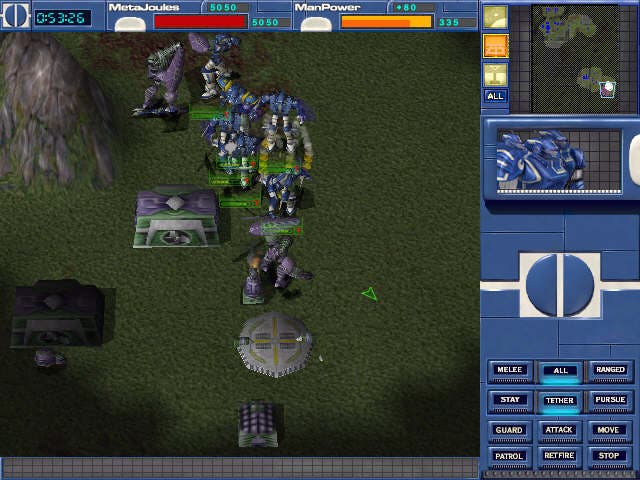Metal Fatigue review
Mecha-based strategy game reviewed

Big Stompy Mecha
Giant robots. Big, huge, humanoid mecha, stomping about the place, making the ground shake, blowing things up, and generally making a nuisance of themselves.
Face it - they're ludicrous. Simple physics and military science tell us that such creations would be utterly useless on any conceivable field of battle... But yet we love them. Many military buffs have a soft spot for mecha, and fans of warfare are thrilled to bits by the sight of these towering beasts.
When it comes to sheer spectacle, mechs have the best of all worlds - on the one hand, their gigantic form and dazzling array of futuristic weaponry is enough to send shivers down the spines of most gun-bunnies, while their humanoid form, often armed with deadly swords and protective shields rather than projectile weapons, brings to mind the glories of battles past, between samurai or medieval knights, rather than the boring, cold precision of modern warfare.
PC games about mecha are numerous, ranging from the simulation-style play of Mechwarrior, through the arcade-influenced Heavy Gear, to the sleek fast behemoths of Shogo. But the use of mecha in real time strategy games has so far been limited. Total Annihilation threw in a few legged units, and MechCommander, as the name suggests, placed you in control of squads of the units from the Mechwarrior series, but concentrating more on squad-based action than traditional RTS values.
Thus, Metal Fatigue is the first really traditional RTS game to use anime-style mechs as a centrepiece; and what a centrepiece! Dwarfing units such as tanks and artillery, and utterly dominating any battlefield engagement, the "Combots" in this game will not disappoint any fan of giant robots.

And The Moral of The Story Is...
The rather sketchy plot of Metal Fatigue has three major "corponations" banding together to research the technology of a seemingly dead alien race called the Hedoth, who have left behind them many many bits and pieces of their advanced military robots.
Naturally, once the true power of the technology becomes apparent, the corponations (RimTech, Mil-Agro and Neuropa) all decide that actually they would rather like to have it for themselves, and hostilities erupt between them. Three brothers caught in the middle of this end up battling for the various different sides, and in the three single player campaigns, you play as one of these brothers.
All of this is explained in the intro movie, and the plot in the campaigns is carried forward by means of a world-weary sounding voiceover. The heavy-handed attempt to make the plot of Metal Fatigue into a moral story is apparent from the outset, and I found myself wondering if the developers could have saved on the voice-acting budget by simply injecting a voice sample of the school councillor from South Park saying "Greed is bad, mmm'kay?" at regular intervals.
Luckily, the plot doesn't intrude into the actual gameplay very much, with mission objectives often fairly unrelated to the storyline. While it is not unusual to get a concise "Destroy the Enemy" objective, you will occasionally get more interesting missions though, calling on you to build defensive perimeters around vital installations, or to capture enemy technology.
It's common to have to keep certain units alive over the course of a mission as well, which can be annoying - the frustration of having a well defended base and then losing the mission because one of your units wandered out into a field and got shot is not to be underestimated. Fortunately the designers have avoided the temptation of throwing the annoying "lone commando" style missions so beloved of the C&C series at you every two minutes.

But Where's Craig Charles?
One of the most interesting parts of Metal Fatigue is the ability to custom-build your Combots to fit specific tasks. The various parts of the bots are built individually, and then assembled according to your specification.
It's also possible to salvage bot parts on the battlefield, carry them back to your base, and either (in the case of an enemy part) research it so that your Parts Factory can build more like it, or fit it on to one of your own Combots as an upgrade. Collecting bot parts after, and even during, battles is a wise strategy, allowing you to build new Combots without the long delay caused by having to manufacture new parts.
As you add new bits and pieces to your bots their on-screen appearance and abilities change dramatically, providing a level of user customisation which adds quite a bit of depth to the game.
Research of new bot parts is often carried over between missions, as are the skills of your Combot pilots, which can be upgraded after each mission using the points you have gathered for fulfilling objectives and bonuses. This adds a certain RPG element to the game, and means that you will go to great lengths to safeguard your best pilots, and make sure that they are always equipped with the best weaponry and shielding possible.
Luckily, when a Combot is destroyed its pilot is ejected rather than dying with it, and it is possible for them to run back to the safety of the base; assuming, of course, that the enemy doesn't spot them and decide to leave a 10 metre wide heel imprint on them...

Underground, Overground, Wombling Free
Aside from the mecha themselves, Metal Fatigue is quite a standard RTS game, although the 3D engine which it uses is rather nice, like a crisper version of the graphics used in Warzone 2100, and will have no difficulty in running on low-end systems. Beyond that, there is little to set this game apart from the mechanics of many older strategy titles.
Except, perhaps, for the unusual three-level battleground. While most battles will as usual take place on the surface of the planet, there are two other levels to the maps - the orbital layer, and the underground layer. Units can be moved about as normal on these, although movement between asteroids in the orbital layer will require hover or flight capable units, and you will need to excavate underground using a drilling unit in order to move about.
Interaction between the three levels is carried out using giant elevators or Star Trek style transporters, and can be crucial to the outcome of a mission. Building solar panels in orbit, for example, frees you from having to collect resources on the ground, while moving attack forces underground can be used as a great flanking movement.

Conclusion
Metal Fatigue is certainly a good-looking game, but I did experience some trouble with graphics settings, causing text to blur at some resolutions, and its OpenGL support is dubious - users are advised to stick to the Direct3D drivers. The game also sounds reasonable, with appropriate (if rather forgettable) music and decent sound effects.
Ultimately there is very little that this game does wrong as an RTS, and the inclusion of the mecha units and the layered map bring it well above average. This isn't a game that sets out to change the world or to redefine the genre, but rather to rehash an existing genre in a solid and playable way. An objective which it achieves with room to spare.

